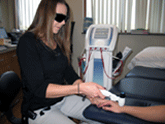|
PT Classroom - Low Level Laser Therapy: Therapeutic Theories, Clinical Uses, and the Evidence ׀ by Jennifer Werwie, DPT |

Jennifer Werwie, DPT, graduated with her Doctor of Physical Therapy degree from the University of Wisconsin-Madison. She received her BS degree in Kinesiology-Exercise Science from UW-Madison in 2008. Jennifer is also a certified personal trainer and fitness instructor. She is a Kenosha native and is an employee with United Hospital System where she primarily works in the outpatient PT setting. |
|
Low Level Laser Therapy: Therapeutic Theories, Clinical Uses, and the Evidence |
| . |
|
The
theoretical foundations of laser were first born back in the early
20th century with Albert Einstein's “Quantum Theory of
Radiation”(1). That has transpired over the years, and today, almost
every section of modern society has found a use for laser
technology: barcode scanners, laser printers, laser light shows,
forensic fingerprint identification, and even electro-optical
countermeasures in the military to name a few. The word, laser,
actually originated as an acronym for "Light Amplification by
Stimulated Emission of Radiation” (1). And the use of laser in the
medical world has erupted in the past couple decades with the laser
scalpel, LASIK eye surgery, laser angioplasty, and laser-assisted
cosmetic and dental treatments (2).
LLLT has been used in physical therapy clinics for a wide range of
conditions such tendinopathies and joint disorders, osteoarthritis, ankle
sprains, carpal tunnel syndrome, low back pain, lateral and medial
epicondylities, and even venous and decubitus ulcers (6-9). Even though LLLT
is being increasingly utilized in therapy settings across the country, all
evidence for its therapeutic use are either in the investigational or
theorized stages. This is simply due to the fact that studies have lacked
strong external validity with their small sample sizes, lack of internal
consistency across studies(wide range of treatment parameters), and lack of
comparing LLLT to alternative therapies (3). Due to this lack of established
evidence, a good majority of insurance companies still consider LLLT as
experimental and investigational, and do not cover the treatment. However,
this has not halted many therapy clinics from employing LLLT treatments with
the recent fee-for-service model. According to a recent article in The
Washington Post, "a laser device costs approximately $4000, while each
treatment costs from $25 to $50 with a typical course of treatment involving
10 to 15 sessions over time (3,8)".
Last revised: October 21, 2012 1) “Laser.” Wikipedia encyclopedia: Sept 2001. Last updated: Oct 15, 2012. http://en.wikipedia.org/wiki/Laser 2) “Lasers; Chapter 5: The Medical Uses of Laser.” 2010. Science Clarified. http://www.scienceclarified.com/scitech/Lasers/Medical-Uses-of-Lasers.html 3) Wang, Grace. Low Level Laser Therapy (LLLT). Technology Assessment. May 2004. Office of Medical Director: Department of Labor & Industries. http://www.lni.wa.gov/claimsins/files/omd/lllttechassessmay032004.pdf 4) ADVANCE Physical Therapy and Rehab. “Effective Treatment Strategies for Low-Level Laser Therapy.”ADVANCE News Magazines. 2012 Merian Matters.http://physical-therapy.advanceweb.com/Web-Extras/Online-Extras/Effective-Treatment-Strategies-for-Low-Level-Laser-Therapy.aspx |
|
|
|
|

 But what do we know about the use of laser light treatment in the
physical therapy realm? Low level laser therapy, or LLLT, has found
a place as an adjunctive therapeutic approach for a variety of both
acute and chronic musculoskeletal conditions. LLLT is a noninvasive,
laser light source treatment that acts via a single wavelength to
produce non-thermal therapeutic effects (3). There is no heat, sound
or vibration involved. Instead, it is theorized that low level laser
therapy acts at the cellular level via varying physiological
mechanisms to produce several therapeutic effects (3, 4):
But what do we know about the use of laser light treatment in the
physical therapy realm? Low level laser therapy, or LLLT, has found
a place as an adjunctive therapeutic approach for a variety of both
acute and chronic musculoskeletal conditions. LLLT is a noninvasive,
laser light source treatment that acts via a single wavelength to
produce non-thermal therapeutic effects (3). There is no heat, sound
or vibration involved. Instead, it is theorized that low level laser
therapy acts at the cellular level via varying physiological
mechanisms to produce several therapeutic effects (3, 4):





